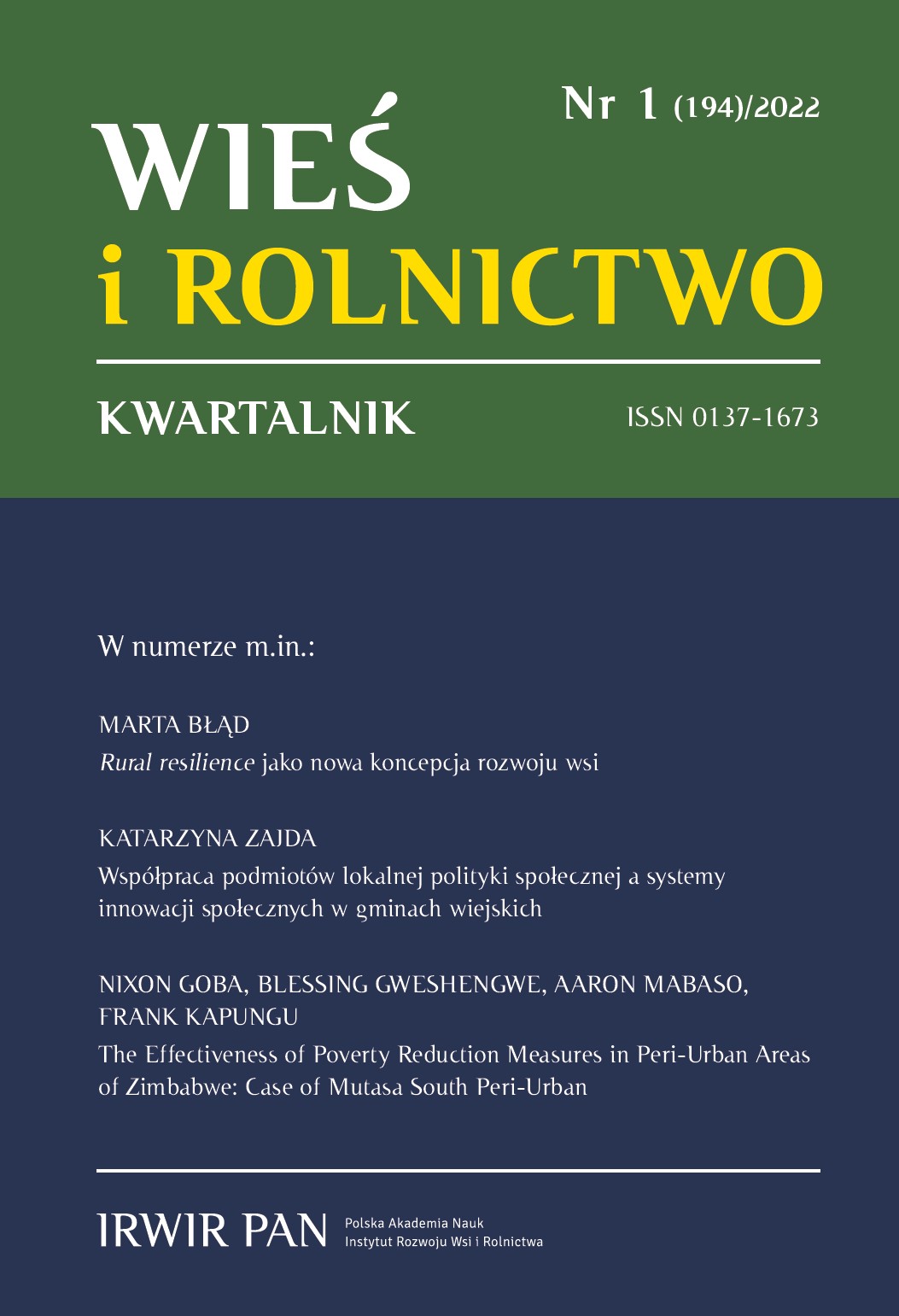Second Homes in the Opinions of the Residents of the Municipality of Czernichów: Negation or Acceptance?
DOI:
https://doi.org/10.53098/wir012022/04Keywords:
second homes, multifunctional rural development, non-agricultural functions of villages, tourist and recreational functions of villages, opinions of local peopleAbstract
The phenomenon of second homes is increasingly discussed in the literature on rural development. Research to date indicates both its negative and positive aspects for rural development. The authors decided to investigate this phenomenon through interviews conducted with permanent residents of the popular, in terms of tourism, municipality of Czernichów (Silesian Voivodeship), where the number of second homes is steadily increasing. The main objective of the study was to present the phenomenon of second homes as assessed by the community members of Czernichów municipality. Based on the literature in the field, both positive and negative effects of the development of second homes in the functional-spatial and social context were identified, which were verified by a questionnaire survey of the inhabitants’ opinion. The vast majority of respondents gave a positive assessment of second homes and its impact on the functioning of the village. There were also a few negative opinions, which confirmed the ambiguous impact of second homes on rural development. However, the second home phenomenon in the municipality of Czernichów were clearly accepted by the inhabitants.
References
Adamiak C. (2014). Drugie domy w Borach Tucholskich. Toruń: Uniwersytet Mikołaja Kopernika.
Adamiak C. (2013). Rola drugich domów w zrównoważonym rozwoju regionu turystycznego na przykładzie regionu Borów Tucholskich. Zeszyty Naukowe. Turystyka i Rekreacja, 2 (12), 137–148. DOI: https://doi.org/10.5604/01.3001.0004.6934
Barnett J. (2014). Host community perceptions of the contributions of second homes. Annals of Leisure Research, 17 (1), 10–26. DOI: https://doi.org/10.1080/11745398.2014.886156
Brida J.G., Osti L., Santifaller E. (2011). Second homes and the need for policy planning. Tourismos: An International Multidisciplinary Journal of Tourism, 6 (1), 141–163.
Czarnecki A. (2018). Wzorce konsumpcji właścicieli drugich domów i ich znaczenie dla wielofunkcyjności wsi. Wieś i Rolnictwo, 2 (179), 209–229. DOI: https://doi.org/10.53098/wir022018/11
Czarnecki A., Dacko A., Dacko M. (2021). Changes in mobility patterns and the switching roles of second homes as a result of the first wave of COVID-19. Journal of Sustainable Tourism, 11, 1–19. DOI: https://doi.org/10.1080/09669582.2021.2006201
Czarnecki A., Heffner K. (2008). „Drugie domy” a zrównoważony rozwój obszarów wiejskich. Wieś i Rolnictwo, 4 (141), 29–46. DOI: https://doi.org/10.53098/wir.2008.4.141/02
Czarnecki A., Sireni M., Dacko M. (2021). Second-home owners as consumers of local food. International Journal of Consumer Studies, 2 (45), 175–187. DOI: https://doi.org/10.1111/ijcs.12610
EEA [European Environment Agency] (2006). Urban Sprawl in Europe: The Ignored Challenge. Copenhagen: European Environment Agency.
Farstad M. (2013). Local residents’ valuation of second home owners’ presence in a sparsely inhabited area. Scandinavian Journal of Hospitality and Tourism, 13 (4), 317–331. DOI: https://doi.org/10.1080/15022250.2013.863062
Farstad M. (2011). Rural residents’ opinions about second home owners’ pursuit of own interests in the host community. Norsk Geografisk Tidsskrift – Norwegian Journal of Geography, 65 (3), 165–174. DOI: https://doi.org/10.1080/00291951.2011.598551
Feltynowski M. (2010). Planowanie przestrzenne na obszarach wiejskich łódzkiego obszaru metropolitarnego a problem rozprzestrzeniania się miast. Infrastruktura i Ekologia Terenów Wiejskich, 13, 111–121.
Gallent N. (2014). The social value of second homes in rural communities. Housing, Theory and Society, 31 (2), 174–191. DOI: https://doi.org/10.1080/14036096.2013.830986
Garton Grimwood G., Cromarty H., Kulakiewicz A. (2022). Second homes and holiday-lets in rural communities. Research Briefing. House of Commons Library, Debate Pack Number CDP 2022/0001, 3, https://researchbriefings.files.parliament.uk/documents/CDP-2022-0001/CDP-2022-0001.pdf (dostęp: 10.10.2021).
Goździewicz-Biechońska J. (2015). Planowanie przestrzenne wobec współczesnych tendencji rozwoju obszarów wiejskich. Przegląd Prawa Rolnego, 2 (17), 167–185.
Hall C.M., Müller D.K. (red.) (2004). Tourism, Mobility and Second Homes: Between Elite Landscape and Common Ground. Clevedon: Channel View. DOI: https://doi.org/10.21832/9781873150825
Heffner K. (2019). Pozarolnicza działalność gospodarcza na obszarach wiejskich. W: M. Stanny, B. Górczyńska, M. Gelo-Kluczyńska (red.). Sto lat rozwoju polskiej wsi: Przegląd bibliograficzny (s. 947–976). Warszawa: Instytut Rozwoju Wsi i Rolnictwa PAN, Wydawnictwo Naukowe Scholar.
Heffner K. (2015). Przestrzeń jako uwarunkowanie rozwoju obszarów wiejskich w Polsce. Wieś i Rolnictwo, 2 (167), 83–103. DOI: https://doi.org/10.53098/wir.2015.2.167/04
Heffner K. (2014). Przestrzeń wiejska w Polsce w perspektywie 2020. Studia Komitetu Przestrzennego Zagospodarowania Kraju, 154, 8–24.
Heffner K., Czarnecki A. (2015). Linking locally: Second home owners and economic development of the rural community. W: E. Kulke, P. Dannenberg (red.). Economic Development in Rural Areas: Functional and Multifunctional Approaches (s. 185–200). Farnham: Ashgate Publishing.
Heffner K., Czarnecki A. (2011). Wpływ zjawiska drugich domów na rozwój obszarów wiejskich. W: K. Heffner, A. Czarnecki (red.). Drugie domy w rozwoju obszarów wiejskich (s. 131–162). Warszawa: Instytut Rozwoju Wsi i Rolnictwa PAN.
Kępkowicz A. (2013). Krajobraz suburbiów – przestrzenny wymiar styku dwóch kultur: wiejskiej i miejskiej. Teka Komisji Architektury, Urbanistyki i Studiów Krajobrazowych, 9 (3), 7–25. DOI: https://doi.org/10.35784/teka.2538
Kłodziński M. (2010). Główne funkcje polskich obszarów wiejskich z uwzględnieniem dezagraryzacji wsi i pozarolniczej działalności gospodarczej. Studia Biura Analiz Sejmowych, 4 (24), 9–28.
Krysiak S. (2009). Ekologiczne aspekty przemian krajobrazów wiejskich Polski środkowej na obszarach występowania osadnictwa turystycznego. Problemy Ekologii Krajobrazu, 25, 19–26.
Krzysztofik M. (2017). Problematyka prawna pojęcia obszaru wiejskiego. Studia Iuridica Lublinensia, 26 (1), 299–314. DOI: https://doi.org/10.17951/sil.2017.26.1.299
Litvin S.W., Xu G., Ferguson A.C., Smith W.W. (2013). Too attractive for its own good? South of broad, second/vacation-homes and resident attitudes. Tourism Management Perspectives, 7, 89–98. DOI: https://doi.org/10.1016/j.tmp.2013.04.003
Monitor Polski (2019). Monitor Polski. Dziennik Urzędowy Rzeczypospolitej Polskiej. Warszawa, dnia 5 grudnia 2019 r., poz. 1150. Uchwała nr 123 Rady Ministrów z dnia 15 października 2019 r. w sprawie przyjęcia „Strategii zrównoważonego rozwoju wsi, rolnictwa i rybactwa 2030”. https://isap.sejm.gov.pl/isap.nsf/download.xsp/WMP20190001150/O/M20191150.pdf (dostęp: 10.10.2021).
Pułaska-Turyna B. (2005). Statystyka dla ekonomistów. Warszawa: Difin.
Rye J.F. (2011). Conflicts and contestations: Rural populations perspectives on the second homes phenomenon. Journal of Rural Studies, 27 (3), 263–274. DOI: https://doi.org/10.1016/j.jrurstud.2011.03.005











